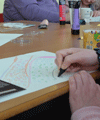March
The brain provides inspiration for art

Scientists from Newcastle University will be taking their work from the lab to the gallery to expose some of the astonishing workings of the brain.
Two exhibitions over Brain Awareness Week (11 – 17th March) will highlight how much our brains have to process in a digital age and what can happen when part of the functioning is faulty.
A week-long exhibition has been spearheaded by a team of young neuroscientists at the Wellcome Trust Centre for Mitochondrial Research at Newcastle University who have been working with local art and community groups.
They have been explaining their research into mitochondrial disease – when the batteries of the cells are affected leading to weakness, fatigue and sometimes debilitating conditions. Sharing some of the vibrant and colourful scientific images of their work has inspired the creation of several pieces which will be displayed at the Great North Museum: Hancock from March 11th.
The exhibition is called Eve’s Curse: The Art of Mitochondrial Research, after Mitochondrial Eve, our common ancestor who lived several thousand years ago. Mitochondrial diseases are a group of conditions passed from mother to child and currently there is no cure. The Newcastle team have developed a transplant technique in the egg which would eradicate the disease – and are waiting to hear in the next week whether it will get the backing of the Human Fertility and Embryology Authority (HFEA) which could lead to a change in the law.
Professor Doug Turnbull, professor of neurology, who leads the research said: “Each unique piece of art that has been created is a reminder of how individual and special each person is. It’s this which inspires our research to ensure the best possibility of a healthy future for each baby.
“Our young scientists have enjoyed explaining their highly technical work and in turn, working with artists we have gained a new found appreciation for some of the slides and scientific images we work with.”
A further interactive exhibition and demonstration on the 16th and 17th March at the Centre for Life will examine how the dramatic rise in information in the digital age can impact on the brain's ability to process data.
It will be a 'distraction machine' comprising of a chair and a number of moving panels of text that mimic a tri-sided billboard. The text will mix research conclusions, philosophical statements and advertising and has been created by artist, David Lisser.
Dr Dr Quoc Vuong, Lecturer in the Institute of Neuroscience at Newcastle University explains: “Our neuroscientists and young researchers will be on hand to explain how the brain copes with and reacts to huge amounts of data. Just think for example, on your way to work how much you have to contend with - road signs, advertising, music in your headphones, emails and news on your phone."
Brain Awareness Week (BAW) is the global campaign to increase public awareness of the progress and benefits of brain research. Every March, BAW unites the efforts of partner organisations worldwide such as Newcastle University in a celebration of the brain for people of all ages.
- Eve’s Curse: The Art of Mitochondrial Research, Great North Museum: Hancock, March 11 – 17th
- Distraction machine, Centre for Life, March 16th – 17th, 11am - 4pm
published on: 11 March 2013
